A Comprehensive Guide to Holistic Child Development in Early Years
VerifiedAdded on 2023/06/14
|8
|2248
|142
Report
AI Summary
This report provides a comprehensive overview of holistic child development in the early years, defining it as the integrated development of a child's intellectual, mental, physical, emotional, and social skills. It explains developmental milestones, including stages, rates, patterns, and sequences of development, and emphasizes the uniqueness of each child, highlighting their individual strengths and weaknesses. The report also discusses the importance of a holistic learning environment that supports all aspects of a learner, including mind, spirit, and body. It identifies biological and environmental factors impacting a child's development journey, the Early Years Foundation Stage (EYFS) framework and its uses, and various non-statutory documents available to practitioners. Furthermore, the report explains the prime areas of learning (PSED, CL, and PD) and characteristics of learning (PE, AL, and CCT). The role and types of observations in early years are discussed, along with ethical considerations and the importance of cultural sensitivity in observing young children. The document concludes with a list of references used to compile the information.
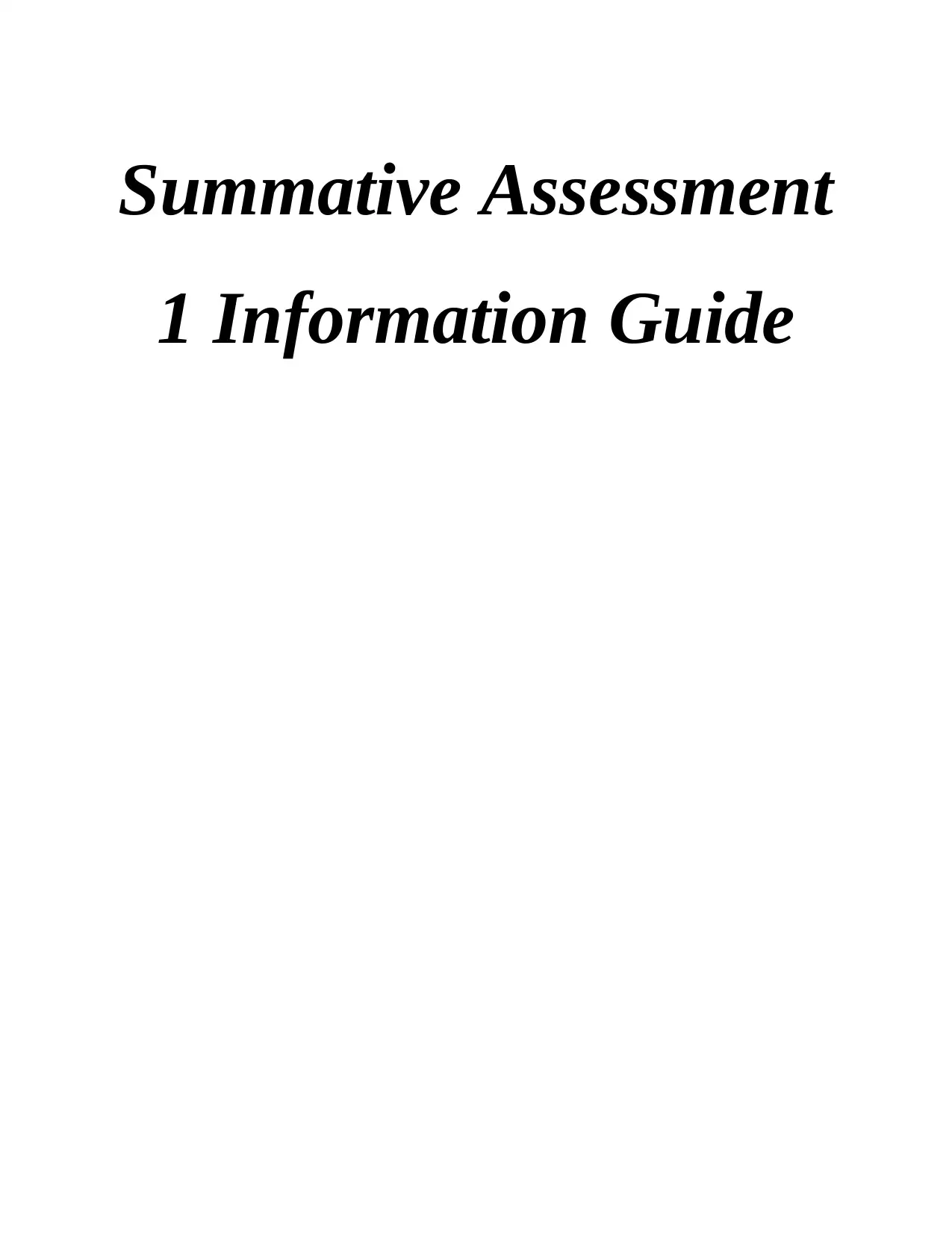
Summative Assessment
1 Information Guide
1 Information Guide
Paraphrase This Document
Need a fresh take? Get an instant paraphrase of this document with our AI Paraphraser
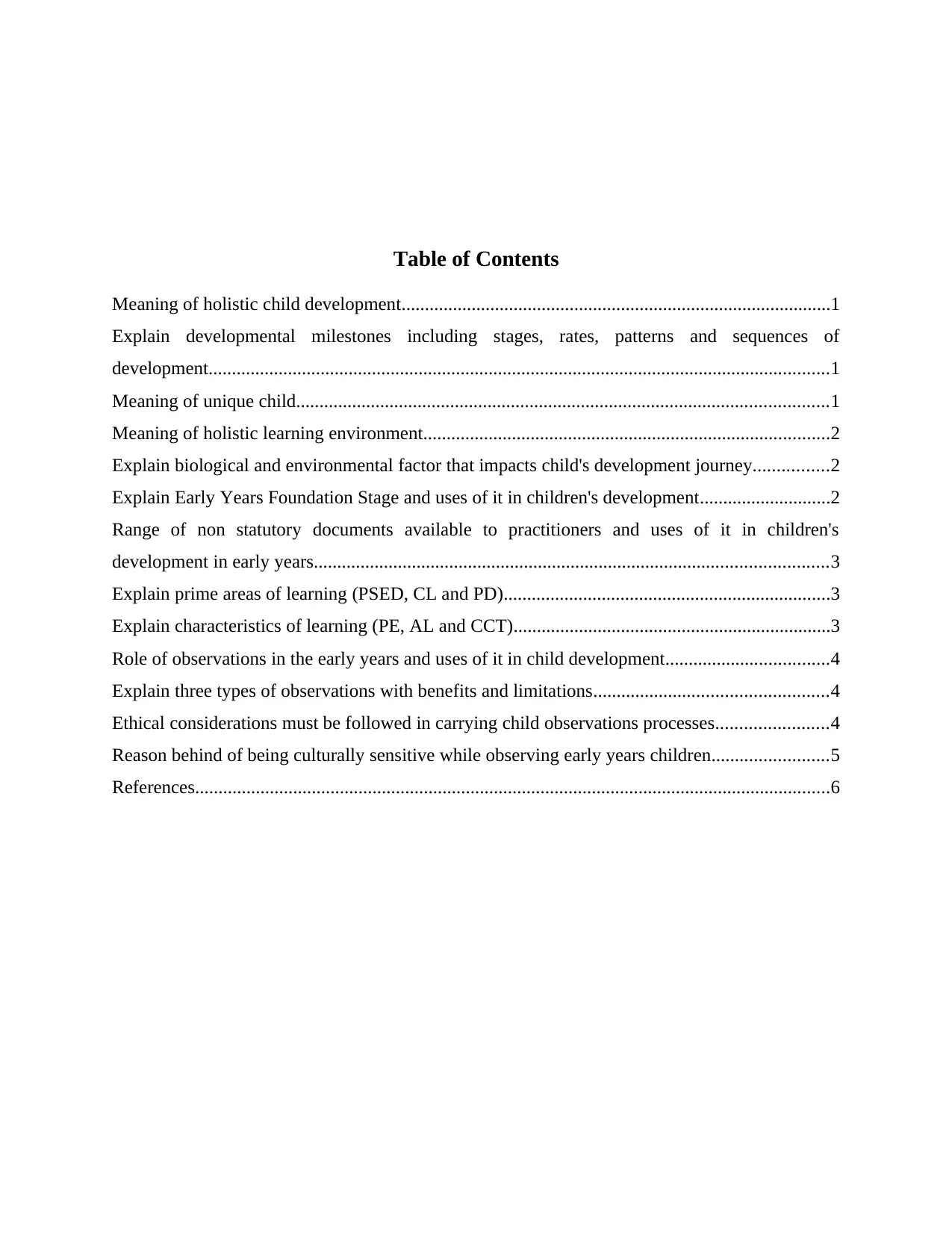
Table of Contents
Meaning of holistic child development............................................................................................1
Explain developmental milestones including stages, rates, patterns and sequences of
development.....................................................................................................................................1
Meaning of unique child..................................................................................................................1
Meaning of holistic learning environment.......................................................................................2
Explain biological and environmental factor that impacts child's development journey................2
Explain Early Years Foundation Stage and uses of it in children's development............................2
Range of non statutory documents available to practitioners and uses of it in children's
development in early years..............................................................................................................3
Explain prime areas of learning (PSED, CL and PD)......................................................................3
Explain characteristics of learning (PE, AL and CCT)....................................................................3
Role of observations in the early years and uses of it in child development...................................4
Explain three types of observations with benefits and limitations..................................................4
Ethical considerations must be followed in carrying child observations processes........................4
Reason behind of being culturally sensitive while observing early years children.........................5
References........................................................................................................................................6
Meaning of holistic child development............................................................................................1
Explain developmental milestones including stages, rates, patterns and sequences of
development.....................................................................................................................................1
Meaning of unique child..................................................................................................................1
Meaning of holistic learning environment.......................................................................................2
Explain biological and environmental factor that impacts child's development journey................2
Explain Early Years Foundation Stage and uses of it in children's development............................2
Range of non statutory documents available to practitioners and uses of it in children's
development in early years..............................................................................................................3
Explain prime areas of learning (PSED, CL and PD)......................................................................3
Explain characteristics of learning (PE, AL and CCT)....................................................................3
Role of observations in the early years and uses of it in child development...................................4
Explain three types of observations with benefits and limitations..................................................4
Ethical considerations must be followed in carrying child observations processes........................4
Reason behind of being culturally sensitive while observing early years children.........................5
References........................................................................................................................................6
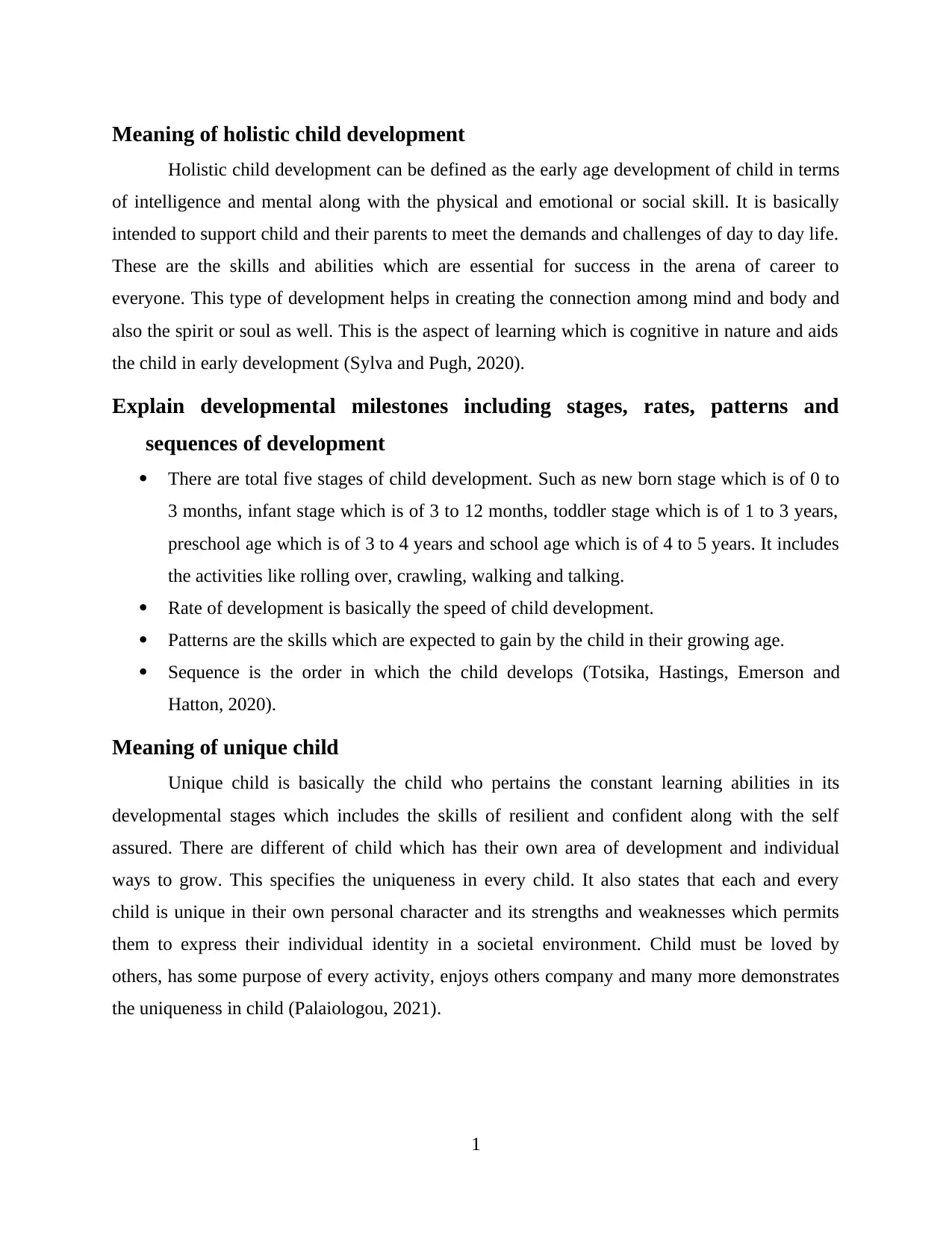
Meaning of holistic child development
Holistic child development can be defined as the early age development of child in terms
of intelligence and mental along with the physical and emotional or social skill. It is basically
intended to support child and their parents to meet the demands and challenges of day to day life.
These are the skills and abilities which are essential for success in the arena of career to
everyone. This type of development helps in creating the connection among mind and body and
also the spirit or soul as well. This is the aspect of learning which is cognitive in nature and aids
the child in early development (Sylva and Pugh, 2020).
Explain developmental milestones including stages, rates, patterns and
sequences of development
There are total five stages of child development. Such as new born stage which is of 0 to
3 months, infant stage which is of 3 to 12 months, toddler stage which is of 1 to 3 years,
preschool age which is of 3 to 4 years and school age which is of 4 to 5 years. It includes
the activities like rolling over, crawling, walking and talking.
Rate of development is basically the speed of child development.
Patterns are the skills which are expected to gain by the child in their growing age.
Sequence is the order in which the child develops (Totsika, Hastings, Emerson and
Hatton, 2020).
Meaning of unique child
Unique child is basically the child who pertains the constant learning abilities in its
developmental stages which includes the skills of resilient and confident along with the self
assured. There are different of child which has their own area of development and individual
ways to grow. This specifies the uniqueness in every child. It also states that each and every
child is unique in their own personal character and its strengths and weaknesses which permits
them to express their individual identity in a societal environment. Child must be loved by
others, has some purpose of every activity, enjoys others company and many more demonstrates
the uniqueness in child (Palaiologou, 2021).
1
Holistic child development can be defined as the early age development of child in terms
of intelligence and mental along with the physical and emotional or social skill. It is basically
intended to support child and their parents to meet the demands and challenges of day to day life.
These are the skills and abilities which are essential for success in the arena of career to
everyone. This type of development helps in creating the connection among mind and body and
also the spirit or soul as well. This is the aspect of learning which is cognitive in nature and aids
the child in early development (Sylva and Pugh, 2020).
Explain developmental milestones including stages, rates, patterns and
sequences of development
There are total five stages of child development. Such as new born stage which is of 0 to
3 months, infant stage which is of 3 to 12 months, toddler stage which is of 1 to 3 years,
preschool age which is of 3 to 4 years and school age which is of 4 to 5 years. It includes
the activities like rolling over, crawling, walking and talking.
Rate of development is basically the speed of child development.
Patterns are the skills which are expected to gain by the child in their growing age.
Sequence is the order in which the child develops (Totsika, Hastings, Emerson and
Hatton, 2020).
Meaning of unique child
Unique child is basically the child who pertains the constant learning abilities in its
developmental stages which includes the skills of resilient and confident along with the self
assured. There are different of child which has their own area of development and individual
ways to grow. This specifies the uniqueness in every child. It also states that each and every
child is unique in their own personal character and its strengths and weaknesses which permits
them to express their individual identity in a societal environment. Child must be loved by
others, has some purpose of every activity, enjoys others company and many more demonstrates
the uniqueness in child (Palaiologou, 2021).
1
⊘ This is a preview!⊘
Do you want full access?
Subscribe today to unlock all pages.

Trusted by 1+ million students worldwide
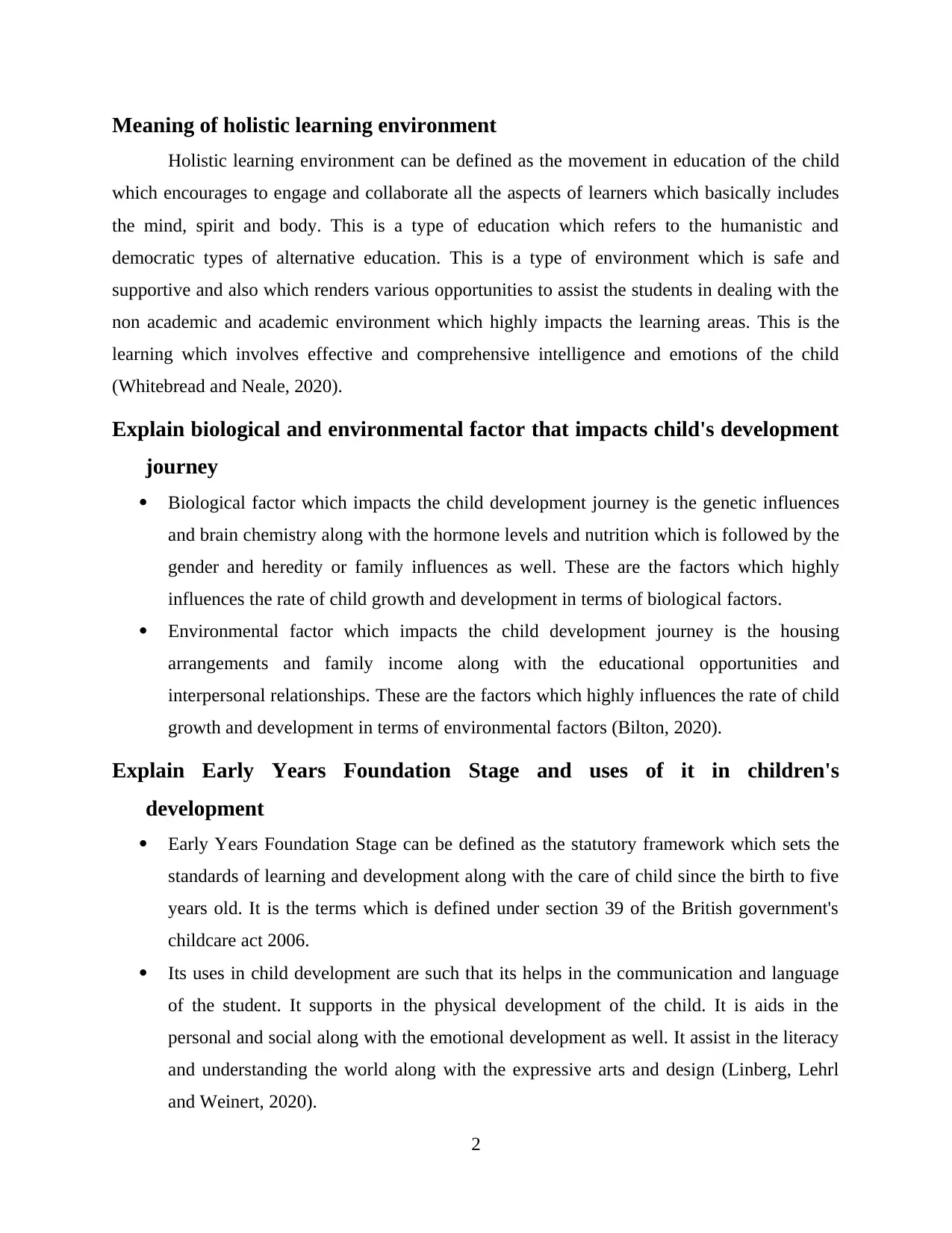
Meaning of holistic learning environment
Holistic learning environment can be defined as the movement in education of the child
which encourages to engage and collaborate all the aspects of learners which basically includes
the mind, spirit and body. This is a type of education which refers to the humanistic and
democratic types of alternative education. This is a type of environment which is safe and
supportive and also which renders various opportunities to assist the students in dealing with the
non academic and academic environment which highly impacts the learning areas. This is the
learning which involves effective and comprehensive intelligence and emotions of the child
(Whitebread and Neale, 2020).
Explain biological and environmental factor that impacts child's development
journey
Biological factor which impacts the child development journey is the genetic influences
and brain chemistry along with the hormone levels and nutrition which is followed by the
gender and heredity or family influences as well. These are the factors which highly
influences the rate of child growth and development in terms of biological factors.
Environmental factor which impacts the child development journey is the housing
arrangements and family income along with the educational opportunities and
interpersonal relationships. These are the factors which highly influences the rate of child
growth and development in terms of environmental factors (Bilton, 2020).
Explain Early Years Foundation Stage and uses of it in children's
development
Early Years Foundation Stage can be defined as the statutory framework which sets the
standards of learning and development along with the care of child since the birth to five
years old. It is the terms which is defined under section 39 of the British government's
childcare act 2006.
Its uses in child development are such that its helps in the communication and language
of the student. It supports in the physical development of the child. It is aids in the
personal and social along with the emotional development as well. It assist in the literacy
and understanding the world along with the expressive arts and design (Linberg, Lehrl
and Weinert, 2020).
2
Holistic learning environment can be defined as the movement in education of the child
which encourages to engage and collaborate all the aspects of learners which basically includes
the mind, spirit and body. This is a type of education which refers to the humanistic and
democratic types of alternative education. This is a type of environment which is safe and
supportive and also which renders various opportunities to assist the students in dealing with the
non academic and academic environment which highly impacts the learning areas. This is the
learning which involves effective and comprehensive intelligence and emotions of the child
(Whitebread and Neale, 2020).
Explain biological and environmental factor that impacts child's development
journey
Biological factor which impacts the child development journey is the genetic influences
and brain chemistry along with the hormone levels and nutrition which is followed by the
gender and heredity or family influences as well. These are the factors which highly
influences the rate of child growth and development in terms of biological factors.
Environmental factor which impacts the child development journey is the housing
arrangements and family income along with the educational opportunities and
interpersonal relationships. These are the factors which highly influences the rate of child
growth and development in terms of environmental factors (Bilton, 2020).
Explain Early Years Foundation Stage and uses of it in children's
development
Early Years Foundation Stage can be defined as the statutory framework which sets the
standards of learning and development along with the care of child since the birth to five
years old. It is the terms which is defined under section 39 of the British government's
childcare act 2006.
Its uses in child development are such that its helps in the communication and language
of the student. It supports in the physical development of the child. It is aids in the
personal and social along with the emotional development as well. It assist in the literacy
and understanding the world along with the expressive arts and design (Linberg, Lehrl
and Weinert, 2020).
2
Paraphrase This Document
Need a fresh take? Get an instant paraphrase of this document with our AI Paraphraser
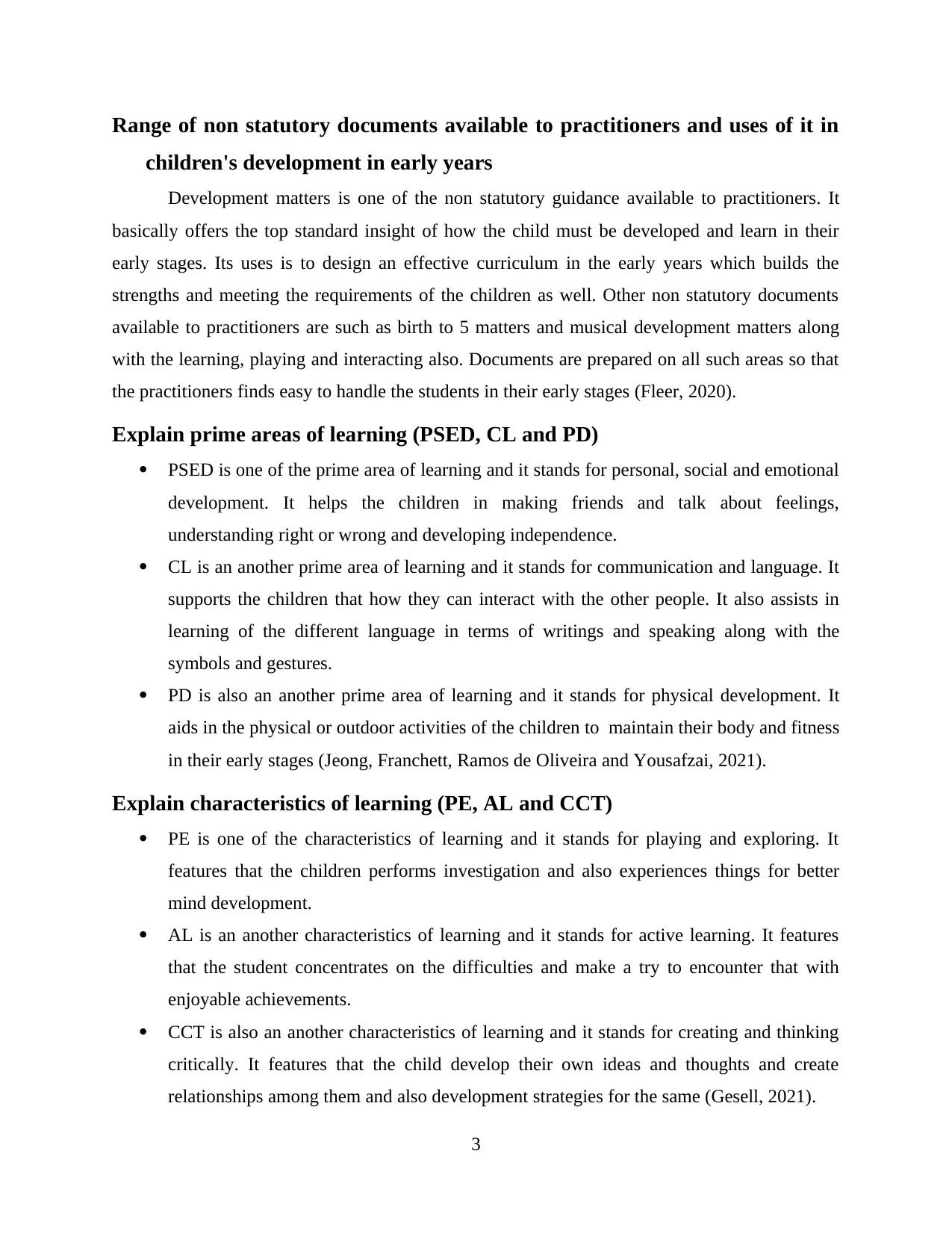
Range of non statutory documents available to practitioners and uses of it in
children's development in early years
Development matters is one of the non statutory guidance available to practitioners. It
basically offers the top standard insight of how the child must be developed and learn in their
early stages. Its uses is to design an effective curriculum in the early years which builds the
strengths and meeting the requirements of the children as well. Other non statutory documents
available to practitioners are such as birth to 5 matters and musical development matters along
with the learning, playing and interacting also. Documents are prepared on all such areas so that
the practitioners finds easy to handle the students in their early stages (Fleer, 2020).
Explain prime areas of learning (PSED, CL and PD)
PSED is one of the prime area of learning and it stands for personal, social and emotional
development. It helps the children in making friends and talk about feelings,
understanding right or wrong and developing independence.
CL is an another prime area of learning and it stands for communication and language. It
supports the children that how they can interact with the other people. It also assists in
learning of the different language in terms of writings and speaking along with the
symbols and gestures.
PD is also an another prime area of learning and it stands for physical development. It
aids in the physical or outdoor activities of the children to maintain their body and fitness
in their early stages (Jeong, Franchett, Ramos de Oliveira and Yousafzai, 2021).
Explain characteristics of learning (PE, AL and CCT)
PE is one of the characteristics of learning and it stands for playing and exploring. It
features that the children performs investigation and also experiences things for better
mind development.
AL is an another characteristics of learning and it stands for active learning. It features
that the student concentrates on the difficulties and make a try to encounter that with
enjoyable achievements.
CCT is also an another characteristics of learning and it stands for creating and thinking
critically. It features that the child develop their own ideas and thoughts and create
relationships among them and also development strategies for the same (Gesell, 2021).
3
children's development in early years
Development matters is one of the non statutory guidance available to practitioners. It
basically offers the top standard insight of how the child must be developed and learn in their
early stages. Its uses is to design an effective curriculum in the early years which builds the
strengths and meeting the requirements of the children as well. Other non statutory documents
available to practitioners are such as birth to 5 matters and musical development matters along
with the learning, playing and interacting also. Documents are prepared on all such areas so that
the practitioners finds easy to handle the students in their early stages (Fleer, 2020).
Explain prime areas of learning (PSED, CL and PD)
PSED is one of the prime area of learning and it stands for personal, social and emotional
development. It helps the children in making friends and talk about feelings,
understanding right or wrong and developing independence.
CL is an another prime area of learning and it stands for communication and language. It
supports the children that how they can interact with the other people. It also assists in
learning of the different language in terms of writings and speaking along with the
symbols and gestures.
PD is also an another prime area of learning and it stands for physical development. It
aids in the physical or outdoor activities of the children to maintain their body and fitness
in their early stages (Jeong, Franchett, Ramos de Oliveira and Yousafzai, 2021).
Explain characteristics of learning (PE, AL and CCT)
PE is one of the characteristics of learning and it stands for playing and exploring. It
features that the children performs investigation and also experiences things for better
mind development.
AL is an another characteristics of learning and it stands for active learning. It features
that the student concentrates on the difficulties and make a try to encounter that with
enjoyable achievements.
CCT is also an another characteristics of learning and it stands for creating and thinking
critically. It features that the child develop their own ideas and thoughts and create
relationships among them and also development strategies for the same (Gesell, 2021).
3
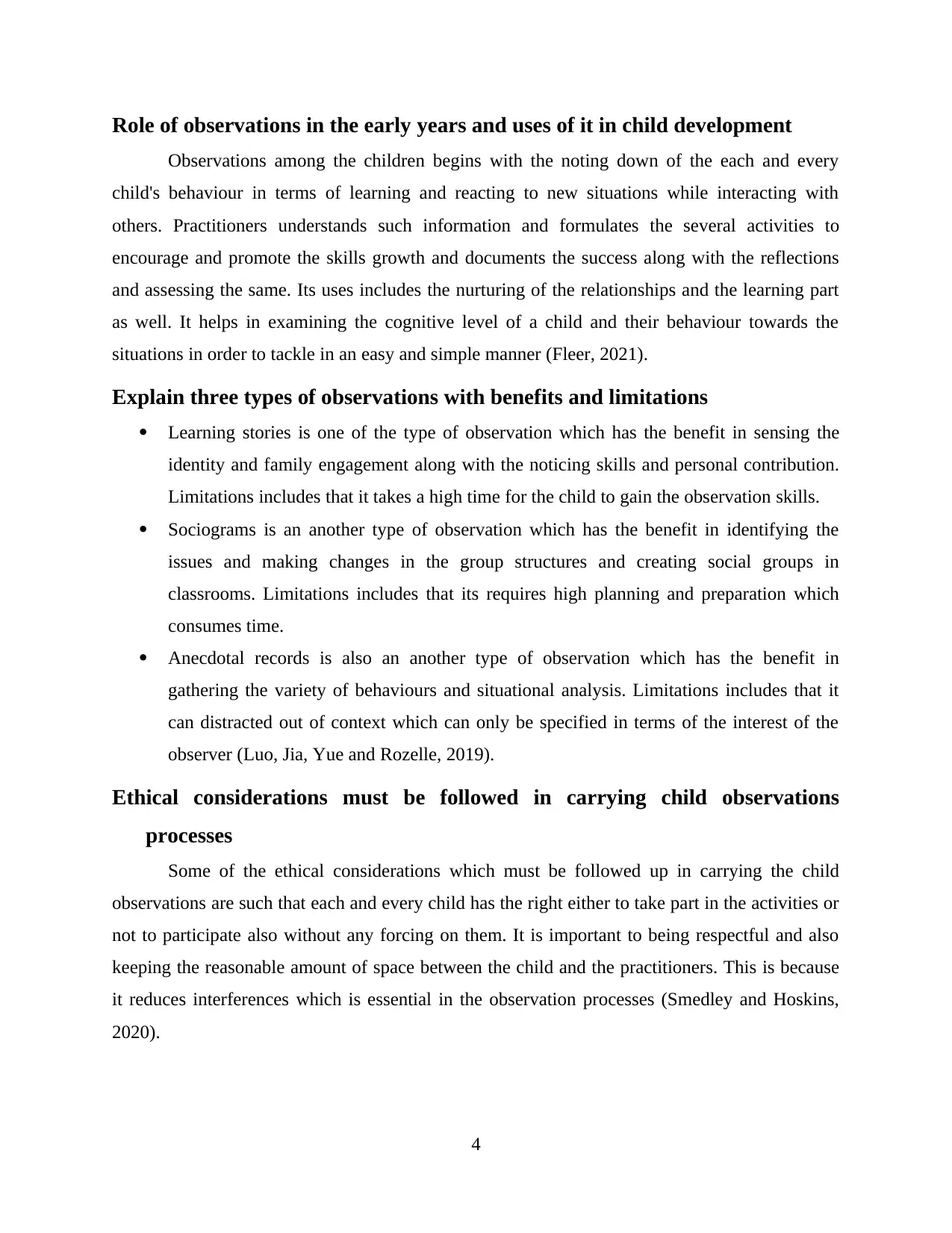
Role of observations in the early years and uses of it in child development
Observations among the children begins with the noting down of the each and every
child's behaviour in terms of learning and reacting to new situations while interacting with
others. Practitioners understands such information and formulates the several activities to
encourage and promote the skills growth and documents the success along with the reflections
and assessing the same. Its uses includes the nurturing of the relationships and the learning part
as well. It helps in examining the cognitive level of a child and their behaviour towards the
situations in order to tackle in an easy and simple manner (Fleer, 2021).
Explain three types of observations with benefits and limitations
Learning stories is one of the type of observation which has the benefit in sensing the
identity and family engagement along with the noticing skills and personal contribution.
Limitations includes that it takes a high time for the child to gain the observation skills.
Sociograms is an another type of observation which has the benefit in identifying the
issues and making changes in the group structures and creating social groups in
classrooms. Limitations includes that its requires high planning and preparation which
consumes time.
Anecdotal records is also an another type of observation which has the benefit in
gathering the variety of behaviours and situational analysis. Limitations includes that it
can distracted out of context which can only be specified in terms of the interest of the
observer (Luo, Jia, Yue and Rozelle, 2019).
Ethical considerations must be followed in carrying child observations
processes
Some of the ethical considerations which must be followed up in carrying the child
observations are such that each and every child has the right either to take part in the activities or
not to participate also without any forcing on them. It is important to being respectful and also
keeping the reasonable amount of space between the child and the practitioners. This is because
it reduces interferences which is essential in the observation processes (Smedley and Hoskins,
2020).
4
Observations among the children begins with the noting down of the each and every
child's behaviour in terms of learning and reacting to new situations while interacting with
others. Practitioners understands such information and formulates the several activities to
encourage and promote the skills growth and documents the success along with the reflections
and assessing the same. Its uses includes the nurturing of the relationships and the learning part
as well. It helps in examining the cognitive level of a child and their behaviour towards the
situations in order to tackle in an easy and simple manner (Fleer, 2021).
Explain three types of observations with benefits and limitations
Learning stories is one of the type of observation which has the benefit in sensing the
identity and family engagement along with the noticing skills and personal contribution.
Limitations includes that it takes a high time for the child to gain the observation skills.
Sociograms is an another type of observation which has the benefit in identifying the
issues and making changes in the group structures and creating social groups in
classrooms. Limitations includes that its requires high planning and preparation which
consumes time.
Anecdotal records is also an another type of observation which has the benefit in
gathering the variety of behaviours and situational analysis. Limitations includes that it
can distracted out of context which can only be specified in terms of the interest of the
observer (Luo, Jia, Yue and Rozelle, 2019).
Ethical considerations must be followed in carrying child observations
processes
Some of the ethical considerations which must be followed up in carrying the child
observations are such that each and every child has the right either to take part in the activities or
not to participate also without any forcing on them. It is important to being respectful and also
keeping the reasonable amount of space between the child and the practitioners. This is because
it reduces interferences which is essential in the observation processes (Smedley and Hoskins,
2020).
4
⊘ This is a preview!⊘
Do you want full access?
Subscribe today to unlock all pages.

Trusted by 1+ million students worldwide
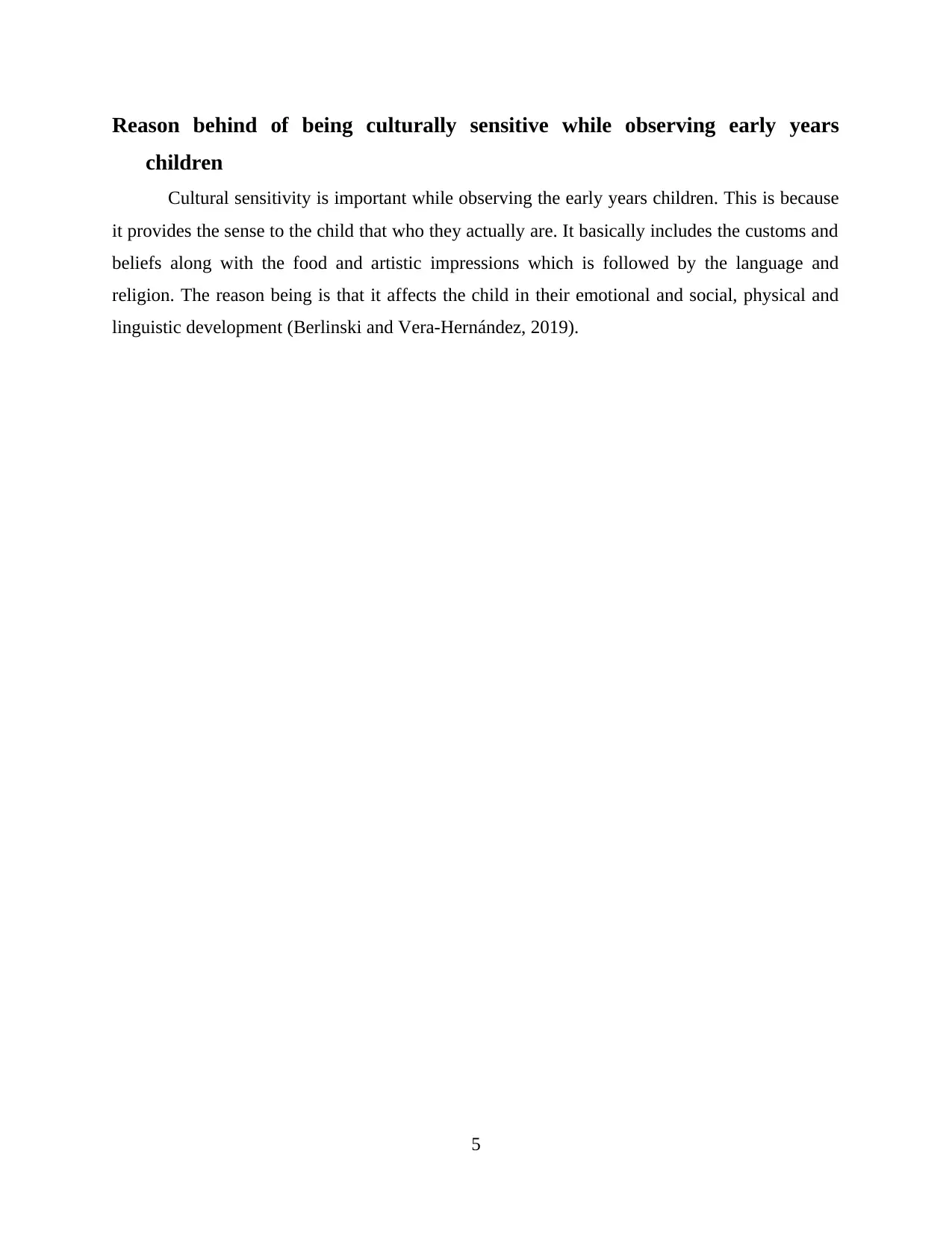
Reason behind of being culturally sensitive while observing early years
children
Cultural sensitivity is important while observing the early years children. This is because
it provides the sense to the child that who they actually are. It basically includes the customs and
beliefs along with the food and artistic impressions which is followed by the language and
religion. The reason being is that it affects the child in their emotional and social, physical and
linguistic development (Berlinski and Vera-Hernández, 2019).
5
children
Cultural sensitivity is important while observing the early years children. This is because
it provides the sense to the child that who they actually are. It basically includes the customs and
beliefs along with the food and artistic impressions which is followed by the language and
religion. The reason being is that it affects the child in their emotional and social, physical and
linguistic development (Berlinski and Vera-Hernández, 2019).
5
Paraphrase This Document
Need a fresh take? Get an instant paraphrase of this document with our AI Paraphraser
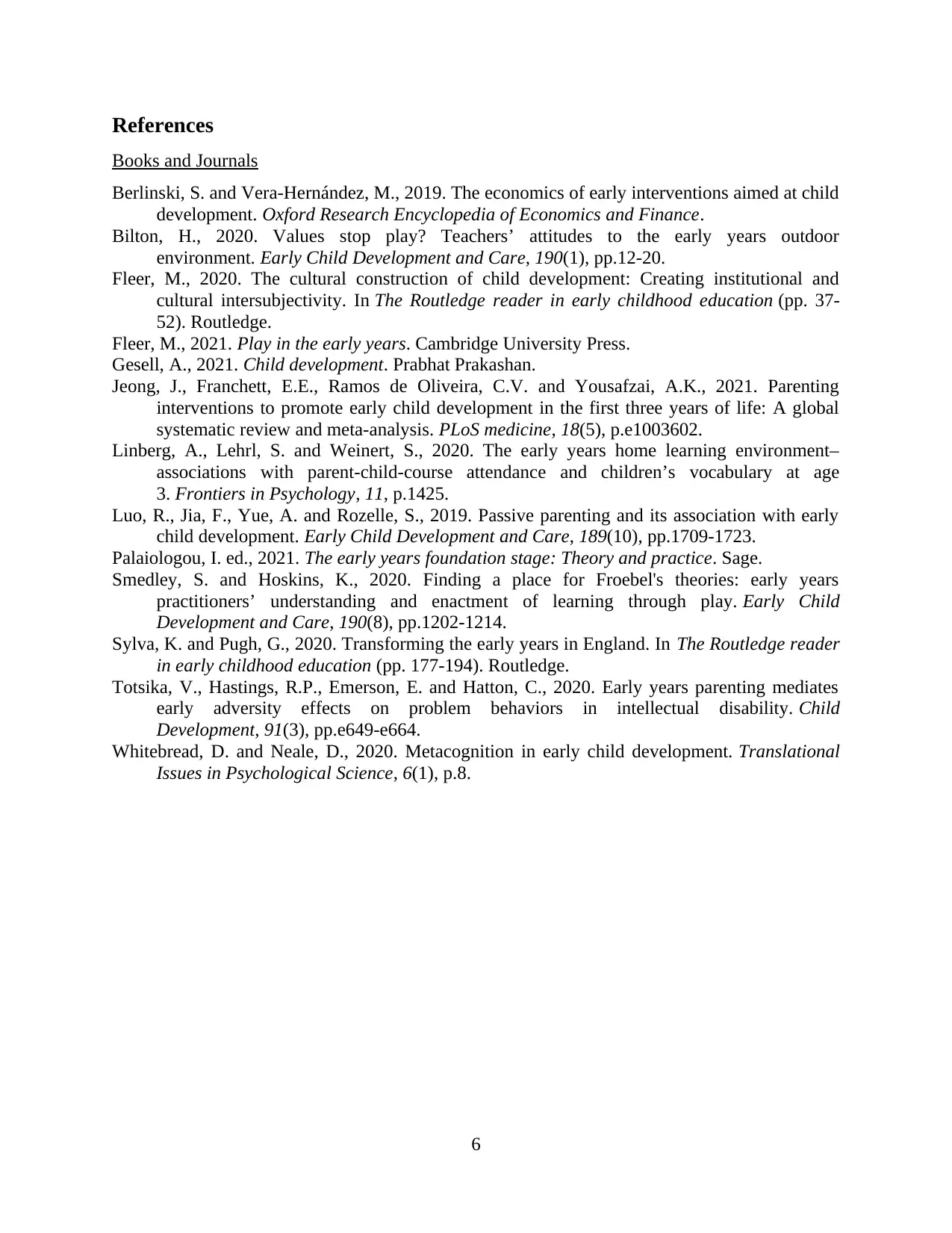
References
Books and Journals
Berlinski, S. and Vera-Hernández, M., 2019. The economics of early interventions aimed at child
development. Oxford Research Encyclopedia of Economics and Finance.
Bilton, H., 2020. Values stop play? Teachers’ attitudes to the early years outdoor
environment. Early Child Development and Care, 190(1), pp.12-20.
Fleer, M., 2020. The cultural construction of child development: Creating institutional and
cultural intersubjectivity. In The Routledge reader in early childhood education (pp. 37-
52). Routledge.
Fleer, M., 2021. Play in the early years. Cambridge University Press.
Gesell, A., 2021. Child development. Prabhat Prakashan.
Jeong, J., Franchett, E.E., Ramos de Oliveira, C.V. and Yousafzai, A.K., 2021. Parenting
interventions to promote early child development in the first three years of life: A global
systematic review and meta-analysis. PLoS medicine, 18(5), p.e1003602.
Linberg, A., Lehrl, S. and Weinert, S., 2020. The early years home learning environment–
associations with parent-child-course attendance and children’s vocabulary at age
3. Frontiers in Psychology, 11, p.1425.
Luo, R., Jia, F., Yue, A. and Rozelle, S., 2019. Passive parenting and its association with early
child development. Early Child Development and Care, 189(10), pp.1709-1723.
Palaiologou, I. ed., 2021. The early years foundation stage: Theory and practice. Sage.
Smedley, S. and Hoskins, K., 2020. Finding a place for Froebel's theories: early years
practitioners’ understanding and enactment of learning through play. Early Child
Development and Care, 190(8), pp.1202-1214.
Sylva, K. and Pugh, G., 2020. Transforming the early years in England. In The Routledge reader
in early childhood education (pp. 177-194). Routledge.
Totsika, V., Hastings, R.P., Emerson, E. and Hatton, C., 2020. Early years parenting mediates
early adversity effects on problem behaviors in intellectual disability. Child
Development, 91(3), pp.e649-e664.
Whitebread, D. and Neale, D., 2020. Metacognition in early child development. Translational
Issues in Psychological Science, 6(1), p.8.
6
Books and Journals
Berlinski, S. and Vera-Hernández, M., 2019. The economics of early interventions aimed at child
development. Oxford Research Encyclopedia of Economics and Finance.
Bilton, H., 2020. Values stop play? Teachers’ attitudes to the early years outdoor
environment. Early Child Development and Care, 190(1), pp.12-20.
Fleer, M., 2020. The cultural construction of child development: Creating institutional and
cultural intersubjectivity. In The Routledge reader in early childhood education (pp. 37-
52). Routledge.
Fleer, M., 2021. Play in the early years. Cambridge University Press.
Gesell, A., 2021. Child development. Prabhat Prakashan.
Jeong, J., Franchett, E.E., Ramos de Oliveira, C.V. and Yousafzai, A.K., 2021. Parenting
interventions to promote early child development in the first three years of life: A global
systematic review and meta-analysis. PLoS medicine, 18(5), p.e1003602.
Linberg, A., Lehrl, S. and Weinert, S., 2020. The early years home learning environment–
associations with parent-child-course attendance and children’s vocabulary at age
3. Frontiers in Psychology, 11, p.1425.
Luo, R., Jia, F., Yue, A. and Rozelle, S., 2019. Passive parenting and its association with early
child development. Early Child Development and Care, 189(10), pp.1709-1723.
Palaiologou, I. ed., 2021. The early years foundation stage: Theory and practice. Sage.
Smedley, S. and Hoskins, K., 2020. Finding a place for Froebel's theories: early years
practitioners’ understanding and enactment of learning through play. Early Child
Development and Care, 190(8), pp.1202-1214.
Sylva, K. and Pugh, G., 2020. Transforming the early years in England. In The Routledge reader
in early childhood education (pp. 177-194). Routledge.
Totsika, V., Hastings, R.P., Emerson, E. and Hatton, C., 2020. Early years parenting mediates
early adversity effects on problem behaviors in intellectual disability. Child
Development, 91(3), pp.e649-e664.
Whitebread, D. and Neale, D., 2020. Metacognition in early child development. Translational
Issues in Psychological Science, 6(1), p.8.
6
1 out of 8
Related Documents
Your All-in-One AI-Powered Toolkit for Academic Success.
+13062052269
info@desklib.com
Available 24*7 on WhatsApp / Email
![[object Object]](/_next/static/media/star-bottom.7253800d.svg)
Unlock your academic potential
Copyright © 2020–2025 A2Z Services. All Rights Reserved. Developed and managed by ZUCOL.





